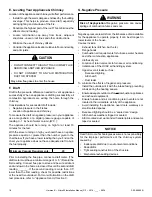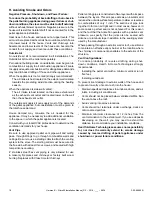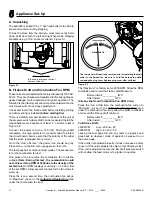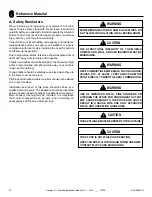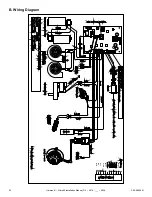
Harman® • Allure50 Installation Manual_R2 • 2016 - ___ • 09/16
19
3-90-888000i
H. Avoiding Smoke and Odors
Negative Pressure, Shut-down, and Power Failure:
To reduce the probability of back-drafting or burn-back in
the pellet burning appliance during power failure or shut-
down conditions, the stove must be able to draft naturally
without exhaust blower operation. Negative pressure in the
house will resist this natural draft if not accounted for in the
pellet appliance installation.
Heat rises in the house and leaks out at upper levels. This
air must be replaced with cold air from outdoors, which flows
into lower levels of the house. Vents and chimneys into
basements and lower levels of the house can become the
conduit for air supply, and reverse under these conditions.
Outside Air
An outside air kit is recommended in all installations. The
Outside Air Kit must be ordered separately.
Per national building codes, consideration must be given to
combustion air supply to all combustion appliances. Failure
to supply adequate combustion air for all appliance demands
may lead to back drafting of those and other appliances.
When the appliance is roof vented (strongly recommended):
The air intake is best located on the exterior wall oriented
towards the prevailing wind direction during the heating
season.
When the appliance is side-wall vented:
The air intake is best located on the same exterior wall
as the exhaust vent outlet and located lower on the wall
than the exhaust vent outlet.
The outside air supply kit can supply most of the demands
of the pellet appliance, but consideration must be given to
the total house demand.
House demand may consume the air needed for the
appliance. It may be necessary to add additional ventilation
to the space in which the pellet appliance is located.
Consult with your local HVAC professional to determine the
ventilation demands for your house.
Vent Pipe
Be sure to use approved pellet vent pipe wall and ceiling
pass- through fittings to go through combustible walls and
ceilings. Be sure to use a starting collar to attach the venting
system to the stove. The starting collar must be secured to
the flue stub with at least three screws, and sealed with high
temp silicone caulking.
4” stainless steel flex vent piping is only allowed for use
in masonry fireplaces and chimneys or factory built wood-
burning fireplaces with Class A metal chimneys.
Pellet venting pipe is constructed of two layers with air space
between the layers. This air space acts as an insulator and
reduces the outside surface temperature to allow a clearance
to combustibles of only 1 inch. The sections of pipe lock
together to form an air tight seal in most cases; however, in
some cases a perfect seal is not achieved. For this reason
and the fact that the Allure50 operates with a positive vent
pressure, we specify that the joints also be sealed with
silicone or aluminum tape in addition to the sealing system
used by the manufacturer.
Where passing through an exterior wall or roof, use silicone
to maintain an effective vapor barrier at the location where
the chimney or component penetrates to the exterior of the
structure.
Vent Configurations:
To reduce probability of reverse drafting during shut-
down conditions, Hearth & Home Technologies strongly
recommends:
• Installing the pellet vent with a minimum vertical run of
five feet.
• Installing outside air.
To prevent soot damage to exterior walls of the house and
to prevent re-entry of soot or ash into the house:
• Maintain specified clearances to windows, doors, and air
inlets, including air conditioners.
• Vents should not be placed below ventilated soffits. Run
the vent above the roof.
• Avoid venting into alcove locations.
• Vents should not terminate under overhangs, decks or
onto covered porches.
• Maintain minimum clearance of 12 inches from the
vent termination to the exterior wall. If you see deposits
developing on the wall, you may need to extend this
distance to accommodate your installation conditions.
Hearth & Home Technologies assumes no responsibility
for, nor does the warranty extend to, smoke damage
caused by reverse drafting of pellet appliances under
shut-down or power failure conditions.














